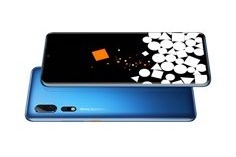Orange is launching Europe’s first operator-branded 5G smartphone, aimed at early adopters. Analysts say other telcos should take note to ensure effective 5G monetisation.
The Orange Neva Jet (pictured) will initially be available on existing 3G and 4G networks, starting with Poland. It will then be available on Orange’s commercial 5G networks across Europe as they go live, starting with Romania, which was switched on last month.
Philippe Lucas, Senior Vice President, Customer Equipment and Partnerships at Orange, commented, “As we gear up to launch our 5G networks in 2020, the Orange Neva jet is testimony to our long-held promise to deliver the very best innovation and technology. This is the start of that journey as we prepare customers for the arrival of 5G.”
The smartphone runs on the Android Pie OS and comes with a 6.47-inch borderless screen with full HD+ definition and integrated AI-based capabilities such as file management, picture correction, phone resources prioritisation and facial recognition. It offers an in-display fingerprint scanner, 128GB of RAM and a triple camera.
The strategy
According to analysts at data and analytics company GlobalData, the move is not aimed at bringing down the 5G smartphone price barrier or at expanding the 5G addressable market to entry-level segments but is rather about providing early 5G adopters with a premium product, offering good specs at a reasonable cost.
“Sub-$300 5G smartphones are not available yet and democratisation will happen further down the line, starting from 2020,” a statement from GlobalData said.
Houda Bostanji, Research Director at GlobalData, commented, “This own-branded device strategy is also designed to provide customers with the guarantee that the device will be interoperable with Orange’s future 5G networks and as such, their investments will not go to waste once 5G networks become more widely available across Orange’s footprint markets.
“Furthermore, the own-branded approach signals to the market that the telco is committed to being an active player in the 5G arena. It helps instil the perception that Orange is trying to help drive the end-to-end consumer 5G ecosystem on the device, network and services sides.”
Driving digital services
The Neva Jet is not the first Orange-branded device. The operator has launched several smartphones across its Europe, Middle East and Africa footprint, with each offering targeted at specific customer segments such as gamers, those seeking simplicity and basic features as well as entry-level users.
GlobalData analysts note that the new device “immerses customers into the telco’s digital services ecosystem, which can help lay down the foundation for future 5G monetisation.”
For instance, the smartphone supports the Orange Livescreen feature – a screen which aggregates content from various streaming, local news and entertainment partners. It also offers the Orange VR Experience and free trials of Orange’s mobile gaming services in some countries.
This could be a useful way to drive content and mobile traffic consumption. Orange reported that the live screen saw a 59% usage increase in Q2 2019 vs Q2 2018.
Thomas Kulinski, Senior Analyst at GlobalData, said, “Video, gaming, augmented reality and virtual reality will be crucial in further making the case for 5G speeds and latencies, driving data traffic and average revenue per user.
“Telcos need to start laying down these foundations, just as Orange is doing so, in the trajectory towards 5G monetisation by bringing together a rich ecosystem of digital services with 5G smartphones encompassing the required capabilities to support these services.”


